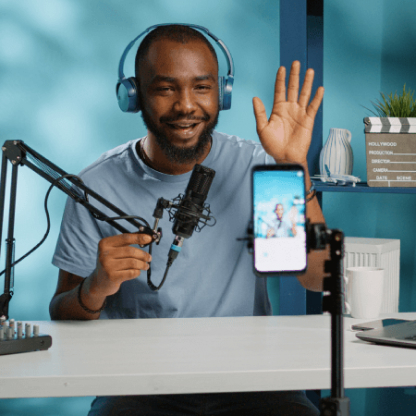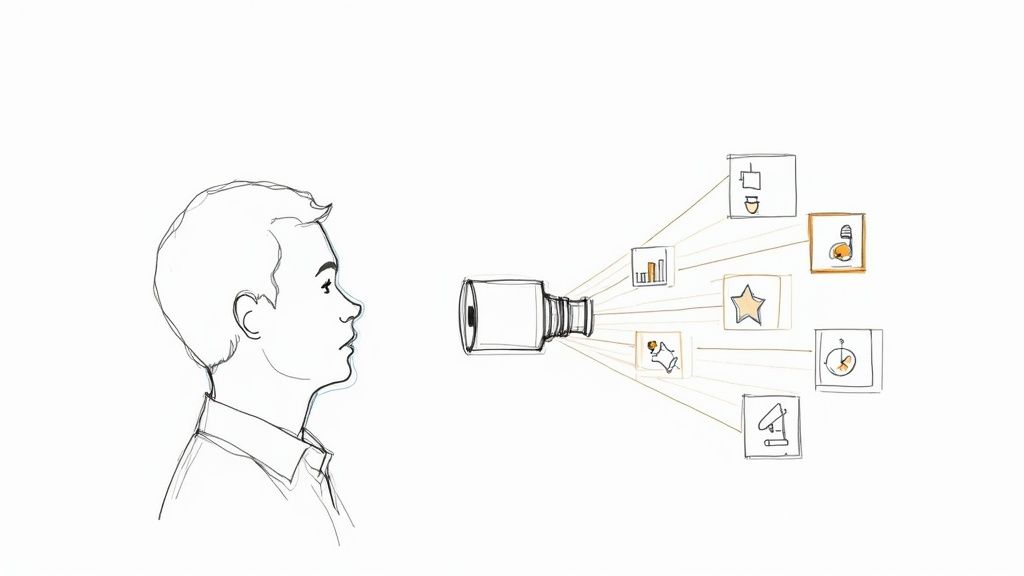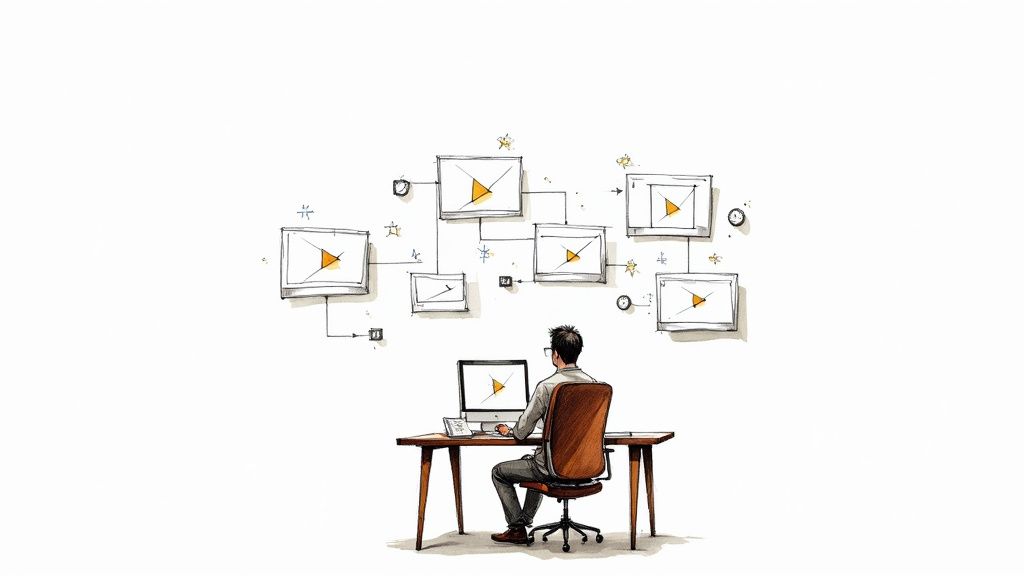An effective interview schedule format isn't just a series of calendar invites. It's your hiring battle plan. It’s the strategic roadmap that outlines every stage, who’s involved, and how long each painful step should take. Get it right, and you evaluate candidates efficiently while respecting everyone’s time. Get it wrong, and… well, we’ll get to that.
Why Your Interview Schedule Is Costing You the Best Hires
Let's be real. Is your current interview scheduling process a chaotic mess of back-and-forth emails and a soul-crushing game of calendar Tetris? If that sounds familiar, it feels broken because it is broken. That clunky, disorganized approach isn't just an internal headache; it's actively pushing away the A-players you're trying so hard to hire.
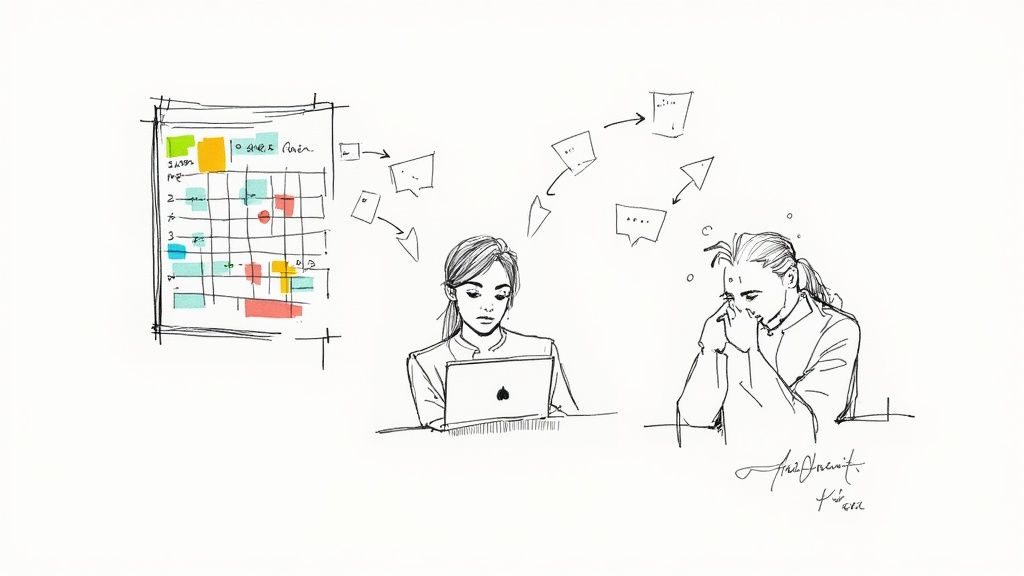
This isn't just a gut feeling—the data backs me up. A shocking 43% of applicants have bailed on a hiring process because of scheduling conflicts alone. When your system is slow and inflexible, you're sending a crystal-clear message to top talent: "You're not our priority."
The real cost of a bad interview schedule isn't the hours your team wastes. It’s the game-changing hire who just accepted an offer from your competitor because their process didn't feel like pulling teeth.
The Silent Killer of Your Hiring Pipeline
Every unnecessary email, every delayed response, every "let me check with the team" adds friction. That friction grinds your hiring pipeline to a halt, giving your best candidates more than enough time to get snapped up by someone who actually has their act together. Digging into business process automation examples is a great way to see how you can mercilessly cut these inefficiencies.
Ultimately, a sloppy schedule creates a poor candidate experience, which is one of the fastest ways to torch your employer brand. You can learn more about how to improve candidate experience right here.
Bottom line: A well-oiled interview schedule does more than fill a role. It signals that your company is decisive, respectful, and exactly the kind of place where top performers want to work. It's time to stop losing the talent war before the first shot is even fired.
Building Your Core Interview Stages: The No-BS Blueprint
Before you even think about sending that first calendar invite, you need a game plan. Stop improvising your interviews. A solid interview schedule format isn’t a random collection of chats; it’s a repeatable, structured process designed to weed out the wrong fits and spotlight the right ones. Fast.
So, where do you start? Forget the complicated flowcharts for a second. Your entire process really just boils down to a few core stages, each with a crystal-clear purpose.
This blueprint shows a typical, no-fluff flow for building out those stages.
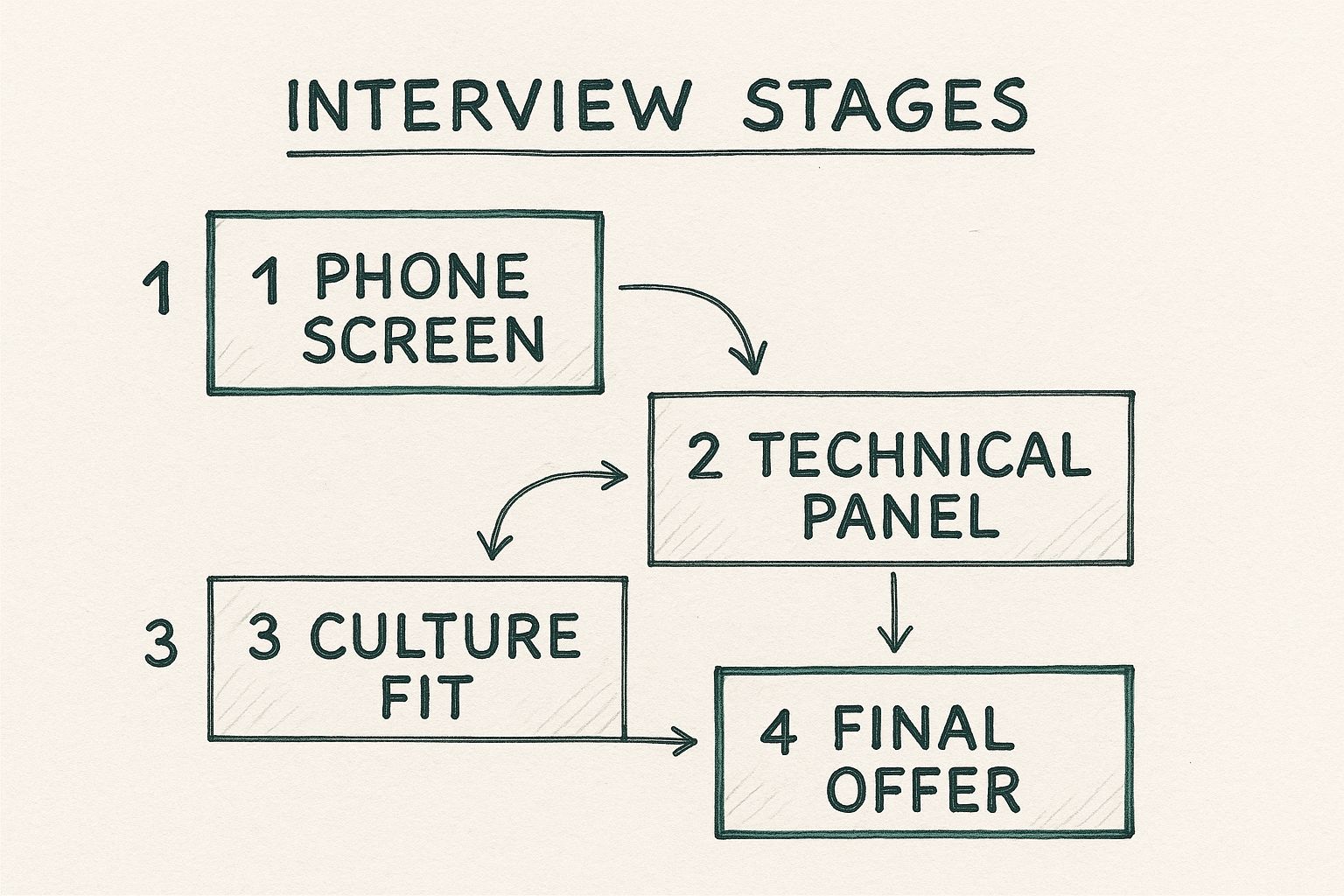
This visual lays out a logical progression, ensuring each step builds on the last without making your candidates want to run for the hills.
The Initial Filter (aka The Bouncer)
First up is the screen. Think of this as your club's bouncer. Its only job is to answer one question: "Is this person's background and motivation a reasonable match for the role?" That’s it.
This is not a deep dive. It's a quick, 15-20 minute phone call or, even better, an asynchronous video screen. The whole point is ruthless efficiency—filter out the obvious "no's" so your hiring managers can focus their energy on a much smaller, more qualified pool of people who might actually be good.
The Technical Deep Dive (aka The Gauntlet)
Next, you bring in the specialists. This is where you test for the hard skills that actually matter. Whether it’s a coding challenge, a portfolio review, or a case study presentation, this stage must be brutally focused on one thing: a candidate’s ability to do the job.
Who should be in the room? Only the people qualified to assess those specific skills. Keep your marketing lead out of the senior backend engineer’s technical interview. It adds noise, not signal. And for the love of all that is holy, it wastes everyone's time.
Example Interview Blueprint for a Technical Role
Here’s a sample breakdown of interview stages for a technical role, outlining the purpose, participants, and duration. Steal this.
| Stage | Purpose | Key Participants | Est. Duration |
|---|---|---|---|
| Recruiter Screen | Assess basic qualifications, salary expectations, and motivation. | Recruiter | 15-20 mins |
| Technical Phone Screen | High-level technical questions and a simple coding problem. | Hiring Manager or Senior Engineer | 45-60 mins |
| Take-Home Challenge | Evaluate practical coding skills and problem-solving approach. | Candidate (offline) | 2-4 hours |
| On-Site/Virtual Loop | In-depth technical assessment, system design, and team collaboration. | 2-3 Senior Engineers, Product Manager | 3-4 hours |
| Culture Contribution | Determine team dynamics, values alignment, and communication style. | Hiring Manager, Key Team Members | 45 mins |
This kind of structure ensures you’re covering all your bases methodically, from initial interest to final team fit.
If you can't define the one thing you need to learn from a candidate in any given stage, that stage shouldn't exist. Period.
The "Are We a Good Fit?" Conversation
Once you've confirmed they have the chops, it's time to see if they’re someone you can actually work with day-to-day. I call this the culture contribution interview, not culture fit. You’re not looking for clones of your existing team; you're looking for someone who adds to it.
Here's what you really want to find out:
- How do they handle conflict? Ask for a real example of a past disagreement, not some hypothetical nonsense.
- What drives their work? Is it the company's mission, the craft itself, or just the paycheck? (Hint: it’s never just the paycheck for A-players).
- Can they actually collaborate? Pay close attention to how they talk about past team projects. Is it all "I, I, I," or is there some "we" in there?
This final stage is all about assessing values, communication style, and collaborative spirit. It’s often the last hurdle before an offer, and it’s where you bring in key team members. Don't you dare skip it.
Choosing Your Scheduling Tools: A Brutally Honest Guide
So you’ve mapped out your perfect interview stages. Fantastic. Now, how do you actually get these meetings on the calendar without setting your hair on fire? It's time for an opinionated look at the tools of the trade.
Forget the neutral, feature-by-feature comparison you’ve seen everywhere else. This is a real-world analysis of what works, what doesn't, and which method is right for your company right now. Are you a scrappy startup trying not to mortgage the office ping-pong table, or a scaling machine where every minute saved is gold?
The Good Old Email Chain (aka The Time Vampire)
Let’s start with the classic: the good old back-and-forth email chain. It’s free, it’s familiar, and for your first few hires, it's… fine. But make no mistake, it’s an absolute soul-crushing time sink once you're juggling multiple candidates and interviewers.
Hope you enjoy spending your afternoons fact-checking time zones and deciphering "Does Tuesday work for you?"—because that’s now your full-time job.
The email method is cheap, but it costs you something far more valuable: momentum. Every "let me check my calendar" is another opportunity for your top candidate to accept an offer elsewhere.
Dedicated Scheduling Software (aka The Sanity Saver)
This is where tools like Calendly and its competitors enter the ring. You send a link, the candidate picks a time, and poof—it’s on everyone's calendar. It’s simple, professional, and it completely slaughters the endless back-and-forth.
Honestly, this should be the baseline for any company that values its time. It seems we're catching on. A recent study found that 51% of recruiters now use scheduling software, and nearly 60% of them report it saves a massive amount of time. Shocking, I know.
Integrated ATS Schedulers (aka The Power Play)
Finally, there’s the scheduler built right into your Applicant Tracking System (ATS). This is often the most powerful option because it keeps everything in one place—candidate profiles, feedback, and scheduling. It creates a single source of truth, which is invaluable as you grow.
The catch? These built-in features can sometimes be clunky or locked behind enterprise plans that cost more than my first car.
So, what's my final take? To really level up your interview process, you should be exploring the market for the best AI calendar tools available.
And for a much deeper dive, check out our guide on how automated interview scheduling can completely transform your workflow. Seriously, ditch the email chains. Your sanity will thank you.
Embracing Asynchronous Video Interviews: Your Secret Weapon
If you’re still banking on live calls for every initial screen, you’re operating in the dark ages. Let's talk about asynchronous video interviews—where candidates record answers on their own schedule. This isn't about replacing human connection with robots; it's a smart filter that makes the time you do spend with candidates incredibly more valuable.
No more calendar gymnastics across time zones. No more frustrating no-shows for that first 15-minute chat. This approach respects a candidate's time and lets your team review submissions when it actually works for them. It’s no surprise that 9 in 10 companies are now using video interviews in their early hiring stages. It's a massive efficiency play. You can dig into these recruitment trends and their impact to see just how common this has become.
Making It Work Without Being a Robot
The trick is to design the experience with a human touch. Your prompts can't be generic snoozers like, "Tell me about yourself." Nobody wants that. Instead, ask something that pulls out their personality and shows you how they think on their feet.
- "What's a project you worked on that you’re genuinely proud of, and why?"
- "Describe a time you had to learn something completely new on a tight deadline."
Here’s a look at what the candidate typically sees—a clean, simple interface. No tricks, just a question and a record button.

This setup creates a clear, low-stress environment for them to put their best foot forward, all without the pressure of a live audience staring back at them.
This isn’t about judging someone’s on-camera performance. It's about getting a richer, more authentic signal than a flat, keyword-stuffed resume could ever provide.
Of course, you have to do it right. Provide crystal-clear instructions, offer a lifeline for tech support, and train your team to evaluate answers consistently to keep bias in check. To really nail the specifics, check out our guide on the best practices for asynchronous video interviews. When done right, this is hands-down the best way to scale the top of your hiring funnel.
Crafting Communication That Actually Works
Alright, let’s talk about the emails you’re sending. Your scheduling software probably just fired off another automated confirmation, and it likely reads with all the personality of a toaster manual. This is a massive missed opportunity.
Every single email—the invitation, the confirmation, the reminder—is a chance to build excitement and show candidates you’re a place that actually cares. Stop treating them like another ticket in the system.
The Anatomy of a Non-Robotic Email
Think beyond the date and time. A great scheduling email provides genuine clarity and sets the stage for a productive conversation. It’s a simple change, but it separates you from the 99% of companies that make candidates feel like just another number.
Here's what your confirmation emails absolutely must include:
- A Clear Agenda: Don't be vague. "We'll be discussing your background" is useless. Try: "We'll spend 30 minutes on your React experience and 15 minutes on our team's approach to code reviews."
- Who They're Meeting: Include names, titles, and LinkedIn profiles for every single interviewer. It’s basic courtesy, and it helps them prepare.
- The "Why": Briefly mention what you’re excited to discuss with them specifically. A single personalized sentence can work wonders.
This isn’t just about being nice; it’s about moving with purpose. Speed and clarity are critical. Data shows that 55% of applicants will just give up if they aren't scheduled for a first interview within a week. You can read the depressing research on why candidates drop out of the hiring process.
A generic, robotic email says, "We're busy and you're just another applicant." A thoughtful, clear email says, "We value your time and we're excited to meet you." The choice is yours.
Frequently Asked Questions, Answered Directly
Let's cut to the chase. When you start overhauling your interview schedule format, the same questions always pop up. Here are the straight, no-fluff answers I've learned from being in the trenches.
How Long Should the Entire Interview Process Take?
As short as humanly possible without sacrificing quality. My rule of thumb? Aim to get from first contact to a final offer in under two weeks. Anything longer and you’re just giving your competitors a head start. If your process takes a month, you don’t have a process; you have a bottleneck.
What's the Ideal Number of Interview Rounds?
Fewer than you think. A great process usually has three to four meaningful stages: a quick screen, a technical/skills assessment, and a team/culture conversation. Every additional round you add has diminishing returns and dramatically increases the odds your top choice will tell you to get lost.
If an interview stage doesn't have a unique, non-negotiable question it needs to answer, it shouldn't exist. Period.
How Do We Handle Scheduling Across Multiple Time Zones?
This is where asynchronous tools become non-negotiable. For initial screens, let candidates record video answers on their own time. It’s a game-changer. For live interviews, offer flexible blocks of time that respect both their schedule and your team’s. Don’t make a candidate in Berlin wake up at 3 AM for a "quick chat." That's just a bad look.
Ready to stop losing great candidates to scheduling chaos? Async Interview helps you screen talent up to 10x faster with asynchronous video interviews that candidates actually love. We’re not saying we’re perfect. Just more accurate more often (toot, toot!). Start your free trial and see the difference at https://asyncinterview.io.
